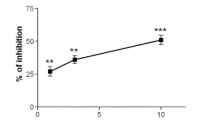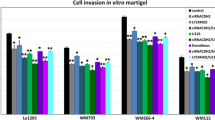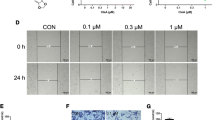Abstract
High mortality rate of melanoma is due to the metastasis of malignant cells. Galbanic acid (GBA) is a natural sesquiterpene coumarin with valuable pharmaceutical activities. Our study aimed to investigate whether GBA can affect the migration, invasion, and adhesion of melanoma cells. The survival rate of B16F10 cells was measured using the alamarBlue assay. Scratch, adhesion, and invasion assays were performed to determine the effect of GBA on metastatic behavior of cells. Moreover, gelatin zymography was done to assess the activity of MMP-2 and MMP-9, and qRT-PCR was used to investigate the effect of GBA on the expression of candidate genes. Based on the results of alamarBlue assay, 40 µM GBA was chosen as the optimum concentration for all tests. Our findings indicated that GBA significantly decreased the invasion and migration of B16F10 cells while enhancing their adhesion ability. In addition, gelatin zymography demonstrated that GBA reduced the enzymatic activity of MMP-2 and MMP-9. Moreover, qRT-PCR revealed that GBA reduced the expression of N-cadherin and fibronectin. Current findings demonstrated, for the first time, that GBA inhibited the migration and invasion of melanoma cells via reducing the activity of MMP-2 and MMP-9 and downregulating N-cadherin and fibronectin expression. Accordingly, GBA could be suggested as a potential therapeutic agent for the treatment of melanoma.






Similar content being viewed by others
Data availability
No datasets were generated or analysed during the current study.
Abbreviations
- BSA:
-
Bovine serum albumin
- DMEM:
-
Dulbecco’s modified Eagle’s medium
- DMSO:
-
Dimethyl sulfoxide
- ECM:
-
Extracellular matrix
- EMT:
-
Epithelial-mesenchymal transition
- FBS:
-
Fetal bovine serum
- GBA:
-
Galbanic acid
- MMPs:
-
Matrix metalloproteinases
- PBS:
-
Phosphate-buffered saline
- PFA:
-
Paraformaldehyde
- qRT-PCR:
-
Quantitative reverse transcription-polymerase chain reaction
- SDS:
-
Sodium dodecyl sulfate
References
Abd-Allah GM, Ismail A, El-Mahdy HA, Elsakka GE, El-Husseiny AA, Abdelmaksoud NM, Salman A, Elkhawaga SY, and Doghish AS (2023) MiRNAs as potential game-changers in melanoma: a comprehensive review. Pathol Res Pract 244:154424. https://doi.org/10.1016/j.prp.2023.154424
Afsharzadeh M, Hashemi M, Babaei M, Abnous K, Ramezani M (2020) PEG-PLA nanoparticles decorated with small-molecule PSMA ligand for targeted delivery of galbanic acid and docetaxel to prostate cancer cells. J Cell Physiol 235:4618–4630. https://doi.org/10.1002/jcp.29339
Aggarwal P, Peter Knabel P, Fleischer JA (2021) United States burden of melanoma and non-melanoma skin cancer from 1990 to 2019. J Am Acad Dermatol 85:388–395. https://doi.org/10.1016/j.jaad.2021.03.109
Ahmed B, Qadir MA, Ghafoor S (2020) Malignant melanoma: skin cancer− diagnosis, prevention, and treatment. Crit Rev Eukaryotic Gene Expr 30(4):291–297. https://doi.org/10.1615/CritRevEukaryotGeneExpr.2020028454
Bobadilla AVP, Arévalo J, Sarró E, Byrne HM, Maini PK, Carraro T, Balocco S, Meseguer A, Alarcón T (2019) In vitro cell migration quantification method for scratch assays. J R Soc Interface 16(151):20180709. https://doi.org/10.1098/rsif.2018.0709
Cao Y, Shi Y, Cai Y, Hong Z, Chai Y (2020) The effects of traditional Chinese medicine on P-glycoprotein–mediated multidrug resistance and approaches for studying the herb–P-glycoprotein interactions. Drug Metab Dispos 48(10):972–979. https://doi.org/10.1124/dmd.120.000050
Carlino MS, Larkin J, Long GV (2021) Immune checkpoint inhibitors in melanoma. The Lancet 398:1002–1014. https://doi.org/10.1016/S0140-6736(21)01206-X
Centeno PP, Pavet V, Marais R (2023) The journey from melanocytes to melanoma. Nat Rev Cancer 23:372–390
Curti BD, Faries MB (2021) Recent advances in the treatment of melanoma. N Engl J Med 384:2229–2240. https://doi.org/10.1056/NEJMra2034861
Czekanska EM (2011) Assessment of cell proliferation with resazurin-based fluorescent dye. Methods Mol Biol 740:27–32. https://doi.org/10.1007/978-1-61779-108-6_5
Davis L, Shalin SC, Tackett AJ (2019) Current state of melanoma diagnosis and treatment. Cancer Biol Ther 20:1366–1379. https://doi.org/10.1080/15384047.2019.1640032
Ebrahimian M, Shahgordi S, Yazdian-Robati R, Etemad L, Hashemi M, Salmasi Z (2022) Targeted delivery of galbanic acid to colon cancer cells by PLGA nanoparticles incorporated into human mesenchymal stem cells. Avicenna J Phytomed 12:295–308. https://doi.org/10.22038/AJP.2022.20022
Frankowski H, Gu YH, Heo JH, Milner R, Del Zoppo GJ (2012) Use of gel zymography to examine matrix metalloproteinase (gelatinase) expression in brain tissue or in primary glial cultures. Methods Mol Biol 814:221–233. https://doi.org/10.1007/978-1-61779-452-0_15
Garbe C, Amaral T, Peris K, Hauschild A, Arenberger P, Basset-Seguin N, Bastholt L, Bataille V, Marmol VD, Dréno B (2022) European consensus-based interdisciplinary guideline for melanoma. Part 1: diagnostics: update 2022. Eur J Cancer 170:236–255. https://doi.org/10.1016/j.ejca.2022.03.008
Geiger TR, Peeper DS (2009) Metastasis mechanisms. Biochim Biophys Acta Rev Cancer 1796:293–308. https://doi.org/10.1016/j.bbcan.2009.07.006
Goudarzi S, Rassouli FB, Kahrizi D, Shirkhani P, Mahdifar M, Iranshahi M, Rafatpanah H, Keramati MR, Ayatollahi H (2022) Comparing toxicity of galbanic acid, auraptene and umbelliprenin on adult T-cell leukaemia-lymphoma in normoxia and hypoxia. Cell Mol Biol 68(12):17–20. https://doi.org/10.14715/cmb/2022.68.12.4
Graf F, Horn P, Ho AD, Boutros M, Maercker C (2021) The extracellular matrix proteins type I collagen, type III collagen, fibronectin, and laminin 421 stimulate migration of cancer cells. FASEB J 35:e21692. https://doi.org/10.1096/fj.202002558RR
Guvakova MA, Prabakaran I, Wu Z, Hoffman DI, Huang Y, Tchou J, Zhang PJ (2020) CDH2/N-cadherin and early diagnosis of invasion in patients with ductal carcinoma in situ. Breast Cancer Res Treat 183:333–346. https://doi.org/10.1007/s10549-020-05797-x
Hall DM, Brooks SA (2014) In vitro invasion assay using Matrigel™: a reconstituted basement membrane preparation. Methods Mol Biol 1070:1–11. https://doi.org/10.1007/978-1-4614-8244-4_1
Hongo K, Tsuno NH, Kawai K, Sasaki K, Kaneko M, Hiyoshi M, Murono K, Tada N, Nirei T, Sunami E, Takahashi K, Nagawa H, Kitayama J, Watanabe T (2013) Hypoxia enhances colon cancer migration and invasion through promotion of epithelial-mesenchymal transition. J Surg Res 182(1):75–84. https://doi.org/10.1016/j.jss.2012.08.034
Kasaian J, Iranshahy M, Iranshahi M (2014) Synthesis, biosynthesis and biological activities of galbanic acid - a review. Pharm Biol 52:524–531. https://doi.org/10.3109/13880209.2013.846916
Kiani A, Almasi K, Shokoohinia Y, Sadrjavadi K, Nowroozi A, Shahlaei M (2015) Combined spectroscopy and molecular modeling studies on the binding of galbanic acid and MMP9. Int J Biol Macromol 81:308–315. https://doi.org/10.1016/j.ijbiomac.2015.08.005
Kim KH, Lee HJ, Jeong SJ, Lee HJ, Lee EO, Kim HS, Zhang Y, Ryu SY, Lee MH, Lü J, Kim SH (2011) Galbanic acid isolated from Ferula assafoetida exerts in vivo anti-tumor activity in association with anti-angiogenesis and anti-proliferation. Pharm Res 28(3):597–609. https://doi.org/10.1007/s11095-010-0311-7
Kumar A, Jaitak V (2019) Natural products as multidrug resistance modulators in cancer. Eur J Med Chem 176:268–291
Leonardi GC, Candido S, Falzone L, Spandidos DA, Libra M (2020) Cutaneous melanoma and the immunotherapy revolution. Int J Oncol 57:609–618. https://doi.org/10.3892/ijo.2020.5088
Lu DY, Lu TR, Wu HY, Cao S (2013) Cancer metastasis treatments. Curr Drug Ther 8:24–29
Naeem A, Farooq MS, Khelifi A, Abid A (2020) Malignant melanoma classification using deep learning: datasets, performance measurements, challenges and opportunities. IEEE Access 8:110575–110597
Peirano D, Donoso F, Vargas S, Hidalgo L, Agüero R, Uribe P, Mondaca S, Navarrete-Dechent C (2023) Patterns of recurrence of cutaneous melanoma: a literature review. Dermatol Pract Concept 13(4):e2023304
Raji E, Vahedian V, Golshanrad P, Nahavandi R, Behshood P, Soltani N, Gharibi M, Rashidi M, Maroufi NF (2023) The potential therapeutic effects of galbanic acid on cancer. Pathol Res Pract 248:154686. https://doi.org/10.1016/j.prp.2023.154686
Saginala K, Barsouk A, Aluru JS, Rawla P, Barsouk A (2021) Epidemiology of melanoma. Med Sci (Basel) 9(4):63
Sajjadi M, Karimi E, Oskoueian E, Iranshahi M, Neamati A (2019) Galbanic acid: induced antiproliferation in estrogen receptor-negative breast cancer cells and enhanced cellular redox state in the human dermal fibroblast. J Biochem Mol Toxicol 33:e22402. https://doi.org/10.1002/jbt.22402
Shahcheraghi SH, Lotfi M, Soukhtanloo M, Ghayour Mobarhan M, Jaliani HZ, Sadeghnia HR, Ghorbani A (2021) Effects of galbanic acid on proliferation, migration, and apoptosis of glioblastoma cells through the PI3K/Akt/MTOR signaling pathway. Curr Mol Pharmacol 14(1):79–87. https://doi.org/10.2174/1874467213666200512075507
Sommariva M, Gagliano N (2020) E-cadherin in pancreatic ductal adenocarcinoma: a multifaceted actor during EMT. Cells 9:1040. https://doi.org/10.3390/cells9041040
Strouhalova K, Přechová M, Gandalovičová A, Brábek J, Gregor M, Rosel D (2020) Vimentin intermediate filaments as potential target for cancer treatment. Cancers (Basel) 12:184. https://doi.org/10.3390/cancers12010184
Tian X, Liu Z, Niu B, Zhang J, Tan TK, Lee SR, Zhao Y, Harris DC, Zheng G (2011) E-cadherin/β-catenin complex and the epithelial barrier. J Biomed Biotechnol 2011:567305. https://doi.org/10.1155/2011/567305
Villani A, Scalvenzi M, Micali G, Lacarrubba F, Fornaro L, Martora F, Potestio L (2023) Management of advanced invasive melanoma: new strategies. Adv Ther 40:3381–3394
Zhang Q, Qiao H, Wu D, Lu D, Liu L, Sang X, Li D, Zhou Y (2019) Curcumin potentiates the galbanic acid-induced anti-tumor effect in non-small cell lung cancer cells through inhibiting Akt/mTOR signaling pathway. Life Sci 239:117044. https://doi.org/10.1016/j.prp.2023.154424
Acknowledgements
This research was financially supported by a research grant (Grant number: 4001585) from the Vice Chancellor of Research of Mashhad University of Medical Sciences, Mashhad, Iran and the Vice-Chancellor for Research and Technology of Ferdowsi University of Mashhad, Mashhad, Iran. The results described in this paper were part of a M.Sc. thesis.
Funding
This research was financially supported by a research grant (Grant number: 4001585) from the Vice Chancellor of Research of Mashhad University of Medical Sciences, Mashhad, Iran, and Ferdowsi University of Mashhad, Mashhad, Iran.
Author information
Authors and Affiliations
Contributions
M.A. and F.H. carried out the experiments, wrote the manuscript, and designed the figures. H.H. and S.G performed part of the experiments. E. M. co-wrote the paper. F. R. and K. J. conceived the original idea and supervised the project. All authors contributed to the final manuscript. The authors declare that all data were generated in-house. The authors declare that all data were generated in-house and that no paper mill was used.
Corresponding authors
Ethics declarations
Ethics approval
This study was approved by the Research Council of Mashhad University of Medical Sciences, Mashhad, Iran (IR.MUMS.MEDICAL.REC.1400.723).
Conflict of interest
The authors declare no competing interests.
Additional information
Publisher's note
Springer Nature remains neutral with regard to jurisdictional claims in published maps and institutional affiliations.
The results described in this paper were part of a M.Sc. thesis.
Masoumeh Azad and Fatemehsadat Hosseini contributed equally to this work.
Rights and permissions
Springer Nature or its licensor (e.g. a society or other partner) holds exclusive rights to this article under a publishing agreement with the author(s) or other rightsholder(s); author self-archiving of the accepted manuscript version of this article is solely governed by the terms of such publishing agreement and applicable law.
About this article
Cite this article
Azad, M., Hosseini, F., Hassanzade, H. et al. Galbanic acid suppresses melanoma cell migration and invasion by reducing MMP activity and downregulating N-cadherin and fibronectin. Naunyn-Schmiedeberg's Arch Pharmacol (2024). https://doi.org/10.1007/s00210-024-02981-4
Received:
Accepted:
Published:
DOI: https://doi.org/10.1007/s00210-024-02981-4




